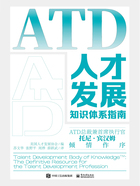
参考文献
Beldoch,M.1964.“Sensitivity to Expression of Emotional Meaning in Three Modes of Communication.” In The Communication of Emotional Meaning,edited by J.R.Davitz and M.Beldoch.New York:McGraw-Hill.
Brackett,M.2019.Permission to Feel:Unlocking the Power of Emotions to Help our Kids,Ourselves,andour Society Thrive.New York:Celadon Books.
Bradberry,T.,and J.Greaves.2009.Emotional Intelligence 2.0.San Diego:TalentSmart.
Cherniss,C.,and M.Adler.2000.Promoting Emotional Intelligence in Organizations.Alexandria,VA:ASTD Press.
Free Management Books.ND.“Paired Comparison Analysis.” www.free-management-ebooks.com/news/paired-comparison-analysis.
Gardner,H.1975.The Shattered Mind.New York:Knopf.
Goleman,D.2001.Primal Leadership.Boston:Harvard Business School Press.
Goleman,D.2006. Emotional Intelligence:Why It Can Matter More Than IQ,10th anniversary edition.New York:Bantam Books.
Hanson,R.,and F.Hanson.2018.Resilient:How to Grow an Unshakable Core of Calm,Strength,and Happiness.New York:Penguin Random House.
HBR Press.2019.Emotional Intelligence Focus.Boston:HBR Press.
Hunt,J.,and M.Fitzgerald.2013.“The Relationship Between Emotional Intelligence and Transformational Leadership:An Investigation and Review of Competing Claims in the Literature.” American International Journal of Social Science2(8):30-38.
Kepner,C.H.,and B.B.Tregoe.1997.The New Rational Manager.Princeton,NJ:Princeton Research Press.
Kohll,A.2017.“How You Can Build a More Resilient Workforce.” Forbes,January 5.www.forbes.com/ sites/alankohll/2017/01/05/how-you-can-build-a-more-resilient-workforce/#536ce39e9b50.
Landy,F.J.2005.“Some Historical and Scientific Issues Related to Research on Emotional Intelligence.” Journal of Organizational Behavior26:411-424.
Mayer,J.2008.“Human Abilities:Emotional Intelligence.” Annual Review of Psychology59:507-536.
Mayer,J.D.,P.Salovey,and D.Caruso.1998.“Competing Models of Emotional Intelligence.” In Handbook of Human Intelligence,edited by R.J.Steinberg.New York:Cambridge University Press.MindTools.ND.“The Vroom-Yetton Decision Model:Deciding How to Decide.” www.mindtools.com/pages/article/newTED_91.htm.
Mulder,P.2017.“Delphi Technique.” Tools Hero.www.toolshero.com/decision-making/delphi-technique.
Nadler,R.2011.Leading with Emotional Intelligence:Hands-on Strategies for Building Confident and Collaborative Star Performers.New York:McGraw-Hill Companies.
Petrides,K.V.,R.Pita,and F.Kokkinaki.2007.“The Location of Trait Emotional Intelligence in Personality Factor Space.” British Journal of Psychology98(2):273-289.
Quinlivan-Hall,D.,and P.Renner.1990.In Search of Solutions.Vancouver,BC:PFR Training Associates.
Rabotin,M.2011.Culture Savvy:Working and Collaborating Across the Globe.Alexandria,VA:ASTD Press.
Salazar,A.2017.“Emotional Intelligence:What Is It,Interpretation Models and Controversies.” CogniFit:July 14.https://blog.cognifit.com/emotional-intelligence.
Sallie-Dosunmu,M.2016.“Using Emotional Intelligence in the Workplace.” TD at Work.Alexandria,VA:ATD Press.
Salovey,P.,and J.Mayer,1990.“Emotional intelligence.” Imagination,cognition,and personality9(3):185-211.
Ullman,D.G.2007.“‘OO-OO-OO!’ The Sound of a Broken OODA Loop.” Crosstalk,April.
Wilkie,D.2014.“Tips for Rooting Out Hidden Bias.” HR Magazine,December 1.